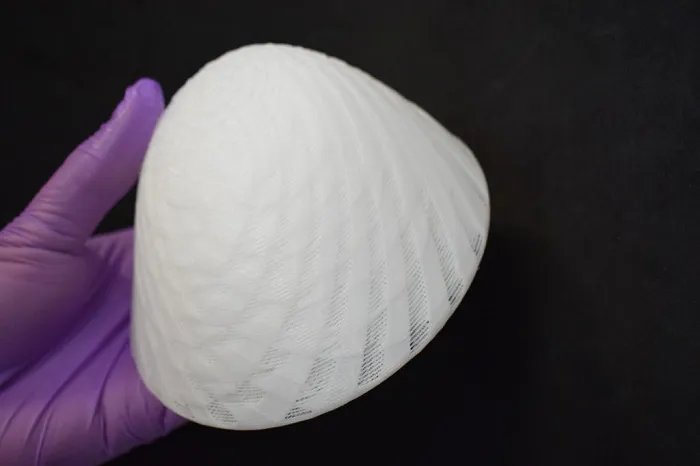A groundbreaking breast implant made from biodegradable materials and designed through 3D printing is gaining attention in the medical field. BellaSeno, a German-Australian medtech company, revealed promising results from its clinical trials during the Aesthetic MEET 2025 conference held in Austin, Texas.
A New Kind of Breast Implant
Unlike traditional silicone or saline implants, BellaSeno’s implants are made from a biodegradable material called polycaprolactone. The implant is a 3D-printed scaffold shaped to match the patient’s breast. During surgery, doctors fill this scaffold with the patient’s own fat, harvested from other parts of the body.
As time passes, the scaffold naturally dissolves. What remains is a breast made entirely from the patient’s own tissue. This process, known as guided tissue regeneration, is designed to reduce the long-term complications often associated with traditional implants.
Clinical Trial Results Show Encouraging Outcomes
At the conference, Dr. Anand Deva, a plastic surgeon and director of cosmetic surgery at Macquarie University in Australia, presented results from a clinical trial involving 19 women. All participants had experienced complications or dissatisfaction with previous silicone implants.
After one year, patients retained 87% of their breast volume. More importantly, there were no major complications reported. Some participants even showed signs of vascularization—where blood vessels form within the new tissue—after two years. This suggests that the body not only accepted the implant but developed new, living tissue around it.
“These clinical study results show that BellaSeno has developed a safe, high-performance alternative to silicone breast implants,” Dr. Deva said. “BellaSeno’s implants enhance and protect the body’s own regenerative potential.”
Moving Beyond Silicone
Silicone implants have been used for more than 60 years and still make up about 80% of breast augmentation surgeries today. However, they come with several risks. Implants can rupture, move, or trigger immune reactions. Over time, patients often need to replace them, leading to additional surgeries and risks associated with anesthesia.
When women decide to remove their implants, options are limited. Fat grafting alone can fail to maintain breast shape, and the procedure itself is complex and invasive. BellaSeno’s 3D-printed scaffolds aim to overcome these issues by combining the benefits of fat grafting and implants without the downsides of either.
Designed for More Than Cosmetic Use
Although BellaSeno’s early trials have focused on women replacing silicone implants, the technology could serve many others. The company hopes its scaffold system will help women who need reconstruction after lumpectomies—a common cancer surgery—and those who want more natural-looking breast augmentation.
Because the scaffolds use the patient’s own fat and dissolve over time, they offer a long-lasting result without the permanence and risks of silicone.
Smart Design with 3D Printing Technology
BellaSeno’s success lies in the precise engineering of its scaffolds. Using advanced 3D printing, the company creates implants with specific shapes, pore sizes, and structural patterns. These design details are not just cosmetic—they help promote blood flow, cell growth, and fat retention.
The polymer used, polycaprolactone, is fully biodegradable and breaks down within two to three years. After it dissolves, only natural tissue remains, offering a lasting and natural solution.
A Company with Global Vision
Founded in 2015, BellaSeno is based in Leipzig, Germany, with an additional office in Brisbane, Australia. Its mission is to combine regenerative medicine with cutting-edge manufacturing to create implants for both soft tissue and bone reconstruction.
BellaSeno produces its scaffolds in compliance with international medical standards (ISO 13485). The company has received support from private investors and public bodies, including the German Federal Ministry of Education and Research and the Australian government.
More Applications on the Horizon
Though the current focus is on breast reconstruction, BellaSeno sees broader possibilities. Its scaffold technology could also support facial reconstruction, fix soft tissue damage, or replace missing bone.
For now, the company continues to conduct clinical trials and gather data. Before BellaSeno’s implants become widely available, the company must secure regulatory approvals like the European CE mark and clearance from the U.S. Food and Drug Administration (FDA).
BellaSeno’s 3D-printed, resorbable breast implants may represent a major step forward in cosmetic and reconstructive surgery. By helping the body heal itself using natural tissue, this technology could offer safer, more permanent results than silicone implants. With ongoing research and regulatory review, the implants could soon become a standard option for patients seeking a more natural and less risky alternative.
Related topics:
- What Is Internal Breast Augmentation?
- New Biological Prosthesis May Redefine Breast Reconstruction
- Reduce Swelling After Breast Lift: Expert Recovery Tips


